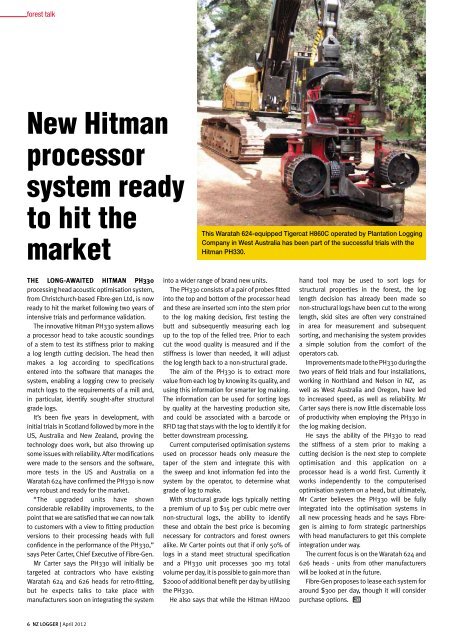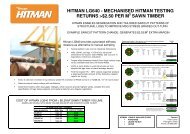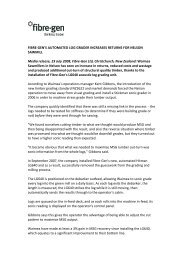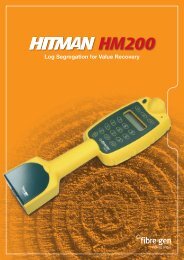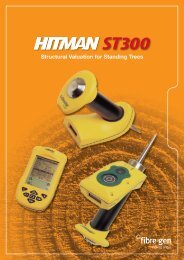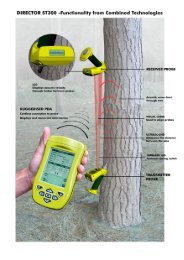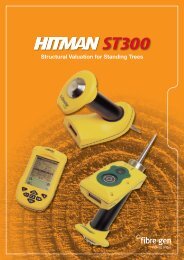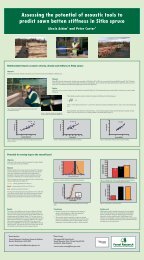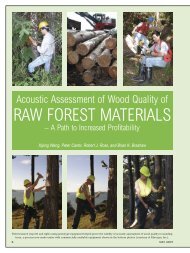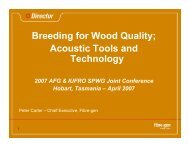Logger PH330.pdf
Logger PH330.pdf
Logger PH330.pdf
- TAGS
- logger
- www.fibre-gen.com
Create successful ePaper yourself
Turn your PDF publications into a flip-book with our unique Google optimized e-Paper software.
forest talk<br />
New Hitman<br />
processor<br />
system ready<br />
to hit the<br />
market<br />
This Waratah 624-equipped Tigercat H860C operated by Plantation Logging<br />
Company in West Australia has been part of the successful trials with the<br />
Hitman PH330.<br />
The long-awaited Hitman PH330<br />
processing head acoustic optimisation system,<br />
from Christchurch-based Fibre-gen Ltd, is now<br />
ready to hit the market following two years of<br />
intensive trials and performance validation.<br />
The innovative Hitman PH330 system allows<br />
a processor head to take acoustic soundings<br />
of a stem to test its stiffness prior to making<br />
a log length cutting decision. The head then<br />
makes a log according to specifications<br />
entered into the software that manages the<br />
system, enabling a logging crew to precisely<br />
match logs to the requirements of a mill and,<br />
in particular, identify sought-after structural<br />
grade logs.<br />
It’s been five years in development, with<br />
initial trials in Scotland followed by more in the<br />
US, Australia and New Zealand, proving the<br />
technology does work, but also throwing up<br />
some issues with reliability. After modifications<br />
were made to the sensors and the software,<br />
more tests in the US and Australia on a<br />
Waratah 624 have confirmed the PH330 is now<br />
very robust and ready for the market.<br />
“The upgraded units have shown<br />
considerable reliability improvements, to the<br />
point that we are satisfied that we can now talk<br />
to customers with a view to fitting production<br />
versions to their processing heads with full<br />
confidence in the performance of the PH330,”<br />
says Peter Carter, Chief Executive of Fibre-Gen.<br />
Mr Carter says the PH330 will initially be<br />
targeted at contractors who have existing<br />
Waratah 624 and 626 heads for retro-fitting,<br />
but he expects talks to take place with<br />
manufacturers soon on integrating the system<br />
into a wider range of brand new units.<br />
The PH330 consists of a pair of probes fitted<br />
into the top and bottom of the processor head<br />
and these are inserted 1cm into the stem prior<br />
to the log making decision, first testing the<br />
butt and subsequently measuring each log<br />
up to the top of the felled tree. Prior to each<br />
cut the wood quality is measured and if the<br />
stiffness is lower than needed, it will adjust<br />
the log length back to a non-structural grade.<br />
The aim of the PH330 is to extract more<br />
value from each log by knowing its quality, and<br />
using this information for smarter log making.<br />
The information can be used for sorting logs<br />
by quality at the harvesting production site,<br />
and could be associated with a barcode or<br />
RFID tag that stays with the log to identify it for<br />
better downstream processing.<br />
Current computerised optimisation systems<br />
used on processor heads only measure the<br />
taper of the stem and integrate this with<br />
the sweep and knot information fed into the<br />
system by the operator, to determine what<br />
grade of log to make.<br />
With structural grade logs typically netting<br />
a premium of up to $15 per cubic metre over<br />
non-structural logs, the ability to identify<br />
these and obtain the best price is becoming<br />
necessary for contractors and forest owners<br />
alike. Mr Carter points out that if only 50% of<br />
logs in a stand meet structural specification<br />
and a PH330 unit processes 300 m3 total<br />
volume per day, it is possible to gain more than<br />
$2000 of additional benefit per day by utilising<br />
the PH330.<br />
He also says that while the Hitman HM200<br />
hand tool may be used to sort logs for<br />
structural properties in the forest, the log<br />
length decision has already been made so<br />
non-structural logs have been cut to the wrong<br />
length, skid sites are often very constrained<br />
in area for measurement and subsequent<br />
sorting, and mechanising the system provides<br />
a simple solution from the comfort of the<br />
operators cab.<br />
Improvements made to the PH330 during the<br />
two years of field trials and four installations,<br />
working in Northland and Nelson in NZ, as<br />
well as West Australia and Oregon, have led<br />
to increased speed, as well as reliability. Mr<br />
Carter says there is now little discernable loss<br />
of productivity when employing the PH330 in<br />
the log making decision.<br />
He says the ability of the PH330 to read<br />
the stiffness of a stem prior to making a<br />
cutting decision is the next step to complete<br />
optimisation and this application on a<br />
processor head is a world first. Currently it<br />
works independently to the computerised<br />
optimisation system on a head, but ultimately,<br />
Mr Carter believes the PH330 will be fully<br />
integrated into the optimisation systems in<br />
all new processing heads and he says Fibregen<br />
is aiming to form strategic partnerships<br />
with head manufacturers to get this complete<br />
integration under way.<br />
The current focus is on the Waratah 624 and<br />
626 heads - units from other manufacturers<br />
will be looked at in the future.<br />
Fibre-Gen proposes to lease each system for<br />
around $300 per day, though it will consider<br />
purchase options. NZL<br />
6 NZ <strong>Logger</strong> | April 2012


